Leveraging Infrastructure BIM for Life-Cycle-Based Sustainable Road Pavement Management
Abstract
1. Introduction
- Definition of a decision support system oriented to reactive and predictive maintenance, which considers the variables related to economic and financial aspects up to the environmental and technical–operational ones related to the decay of specific status indicators; the framework must be compliant with ISO 19650 information management protocols (see Figure 1) and is aimed at automating the drafting of a multiyear maintenance plan for a road pavement section.
- The introduction of laboratory results related to road construction materials (i.e., composition of the mixtures and features of primary and secondary raw materials, as well as the physical, mechanical and performance-related attributes and predictive equations useful for designing and predicting the service life of asphalt pavement configurations) into a BIM workflow.
- Digitization of the road pavement management process through the definition of a pavement information model aimed at IBIM-based sustainable maintenance management. Integration is intended not only for the automation of data management but also for the definition of specific information exchange management protocols related to the life cycle of a road pavement.
2. Methodology
2.1. Condition Indicators and Alternative Maintenance Strategies
- Surface rehabilitation: it implies the milling and reconstruction of the wearing course and the assessment of the condition of the binder layer (i.e., extraction of core samples from the binder layer to test the stiffness modulus, in situ testing to measure the bearing capacity of the deeper layers, etc.);
- Deep rehabilitation: it consists of the milling and reconstruction of the wearing course and binder layer (and relative tests applied to measure the structural capacity of the base layer, i.e., coring of the base layer and stiffness measurement);
- Reconstruction: it involves the full reconstruction of the asphalt layers (wearing, binder and base layer) and subsequent control of the subbase bearing capacity.
- PCI values above 85 imply no maintenance interventions due to the good quality of the pavement surface.
2.2. Environmental and Economic Assessment of Alternatives
2.3. Decision Making
- Determining the weights of the attributes;
- Normalizing the attribute values for each alternative;
- Aggregating the normalized attribute values into an overall index to produce the ranking of the alternatives [47].
3. Results and Discussion
- Tables S1 and S2 collect the mix composition data of the asphalt mixtures under analysis, respectively, for the binder and base layers;
- Table S4 collects all the available data regarding the road category, the AADT and the expected number of ESALs in 20 y for the case study under analysis, on which pavement design was based;
- Table S5 summarizes the results in terms of the type of maintenance intervention, expected frequency of intervention and materials involved;
- Table S6 collects all the data sources and relative survey year of LCA data;
- Table S7 summarizes all the cost items of the alternative maintenance strategies;
- Table S8 reports the final decision matrix of the case study.
- Set up data templates (i.e., Excel spreadsheets) to import the needed information in the programming interface and speed up the informatization of the pavement information model;
- Informatize the IBIM of a road pavement through property sets definition;
- Run calculations and update the property sets with the outcome of the maintenance algorithm and decision-making framework.
- Input property: its value is assigned directly from the data template imported by the user and does not require additional calculations;
- Output property: its value is the result of the calculations of the analytic tools supporting the pavement IBIM.
- Pset_Pavement: the property set includes the current features of the asphalt pavement, such as the asphalt mixture identifiers of each layer and the coefficients of the PCI, FD and R decay curves;
- Pset_WearingCourse, Pset_BinderLayer, Pset_BaseLayer: the three input property sets, each one attached to the respective asphalt layer of the pavement structure, include all the necessary information that should be uploaded in the BIM environment before performing the LCA in absence of a specific EPD;
- Pset_MADM: the property set includes the input parameters that set up the boundary conditions for MADM (the weighting coefficients of each indicator and the maximum budget constraint in the analysis period);
- Pset_Maintenance: the property set includes both input (analysis period) and output parameters (type of maintenance strategy, number of years before next maintenance intervention, relative trigger condition and value of each condition indicator before next maintenance intervention) referred to the current pavement configuration;
- Pset_LCAindicators: the output property set includes the environmental impact categories that will be filled once the analysis tool is run on the current pavement configuration. In particular, hierarchical recipe midpoint impact assessment methodology [41] was chosen to address 18 different environmental problems through as many impact category indicators;
- Pset_LCCAindicators: the property set includes both input (discount rate) and output parameters (LCCA indicator and salvage value of the pavement at the end of the analysis period) used to characterize the life cycle cost dimension of the current pavement configuration.
- The PMS tool gathers the information (time series of PCI surveys, predictive rutting and fatigue accumulations laws, pavement solutions library, intervention thresholds, etc.) and calculates the type and timing of the maintenance interventions according to different maintenance approaches;
- The LCA/LCCA (see respectively Figure 5a,b) tool gathers the outputs of the PMS tool, as well as the libraries of unit costs and impact category indicators for each stage of the expected life cycle of the pavement, to calculate a set of life cycle indicators for each alternative pavement solution;
- The MADM (see Figure 5c) tool applies the budget constraints and performs the final decision making based on the decision matrix set up by the execution of the previous analysis tools. The MADM tool also updates the final values of the output properties, including the number of years before the next intervention, the condition indicator that triggers the need for maintenance, the cost and the environmental impact indicators of the life cycle of the optimal solution.
Application to a Case Study
- The performance indicators at the end of the analysis period, namely, FD, R and PCI (where available), make up the overall pavement condition (PC);
- The LCC indicator alone represents the costs incurred by the road managing agency in the analysis period (LCCA);
- The 18 indicators obtained by LCA analysis were collected to constitute the environmental and human health performance of the asphalt mixtures (EHP).
4. Conclusions
Supplementary Materials
Author Contributions
Funding
Institutional Review Board Statement
Informed Consent Statement
Data Availability Statement
Conflicts of Interest
References
- Santos, J.; Ferreira, A. Life-cycle cost analysis system for pavement management at project level. Int. J. Pavement Eng. 2013, 14, 71–84. [Google Scholar] [CrossRef]
- Babashamsi, P.; Yusoff, N.I.M.; Ceylan, H.; Nor, N.G.M.; Jenatabadi, H.S. Evaluation of pavement life cycle cost analysis: Review and analysis. Int. J. Pavement Res. Technol. 2016, 9, 241–254. [Google Scholar] [CrossRef]
- Teicholz, P. BIM for Facility Managers; John Wiley & Sons: Hoboken, NJ, USA, 2013; p. 352. [Google Scholar]
- Santos, J.; Bressi, S.; Cerezo, V.; Presti, D.L.; Dauvergne, M. Life cycle assessment of low temperature asphalt mixtures for road pavement surfaces: A comparative analysis. Resour. Conserv. Recycl. 2018, 138, 283–297. [Google Scholar] [CrossRef]
- Zhu, H.; Cai, H.; Yan, J.; Li, H.; Li, H. Incorporating life cycle science into asphalt pavement maintenance decision making. In Proceedings of the Transportation Research Congress 2016: Innovations in Transportation Research Infrastructure, Beijing, China, 6–8 June 2016. [Google Scholar]
- Russo, F.; Oreto, C.; Veropalumbo, R. A Practice for the Application of Waste in Road Asphalt Pavements in an Eco-Friendly Way. Appl. Sci. 2021, 11, 9268. [Google Scholar] [CrossRef]
- Veropalumbo, R.; Oreto, C.; Viscione, N.; Biancardo, S.A.; Russo, F. Environmental assessment of asphalt mastics containing plastic bottles and jet grouting waste. Environ. Impact Assess. Rev. 2022, 93, 106736. [Google Scholar] [CrossRef]
- Viscione, N.; Lo Presti, D.; Veropalumbo, R.; Oreto, C.; Biancardo, S.A.; Russo, F. Performance-based characterization of re-cycled polymer modified asphalt mixture. Constr. Build. Mater. 2021, 310, 125243. [Google Scholar] [CrossRef]
- Turk, J.; Pranjić, A.M.; Mladenovič, A.; Cotič, Z.; Jurjavčič, P. Environmental comparison of two alternative road pavement rehabilitation techniques: Cold-in-place-recycling versus traditional reconstruction. J. Clean. Prod. 2016, 121, 45–55. [Google Scholar] [CrossRef]
- Polo-Mendoza, R.; Peñabaena-Niebles, R.; Giustozzi, F.; Martinez-Arguelles, G. Eco-friendly design of Warm mix asphalt (WMA) with recycled concrete aggregate (RCA): A case study from a developing country. Constr. Build. Mater. 2022, 326, 126890. [Google Scholar] [CrossRef]
- Guinée, J.B. Handbook on Life Cycle Assessment: Operational Guide to the ISO Standards; Springer Science & Business Media: Berlin/Heidelberg, Germany, 2002; Volume 7, p. 692. [Google Scholar]
- van Eldik, M.A.; Vahdatikhaki, F.; dos Santos, J.M.O.; Visser, M.; Doree, A. BIM-based environmental impact assessment for infrastructure design projects. Autom. Constr. 2020, 120, 103379. [Google Scholar] [CrossRef]
- Guerra De Oliveira, S. Sustainability of Linear Infrastructure Domain-Specific Data Sets in Open BIM Asset Centric Workflows. Ph.D. Thesis, University of Naples Federico II, Napoli, Italy, 2020. [Google Scholar]
- Wang, Y. Research on Pavement Preventive Maintenance Decision-making Method Based on BIM Technology. J. Phys. Conf. Ser. 2021, 1744, 022094. [Google Scholar] [CrossRef]
- Biancardo, S.A.; Viscione, N.; Oreto, C.; Russo, F. BIM approach for smart infrastructure design and maintenance operations. In Models and Technologies for Smart, Sustainable and Safe Transportation Systems; De Luca, S., Di Pace, R., Fiori, C., Eds.; IntechOpen: London, UK, 2020. [Google Scholar]
- Delgado, J.M.D.; Butler, L.; Brilakis, I.; Elshafie, M.; Middleton, C. Structural performance monitoring using a dynamic data-driven BIM environment. J. Comput. Civ. Eng. 2018, 32, 04018009. [Google Scholar] [CrossRef]
- Tang, F.; Ma, T.; Guan, Y.; Zhang, Z. Parametric modeling and structure verification of asphalt pavement based on BIM-ABAQUS. Autom. Constr. 2020, 111, 103066. [Google Scholar] [CrossRef]
- Lee, N.; Salama, T.; Wang, G. Building information modeling for quality management in infrastructure construction projects. In Computing in Civil and Building Engineering; American Society of Civil Engineers: Reston, VA, USA, 2014; pp. 65–72. [Google Scholar] [CrossRef]
- Ding, L.; Li, K.; Zhou, Y.; Love, P.E. An IFC-inspection process model for infrastructure projects: Enabling real-time quality monitoring and control. Autom. Constr. 2017, 84, 96–110. [Google Scholar] [CrossRef]
- Abbondati, F.; Biancardo, S.A.; Palazzo, S.; Capaldo, F.S.; Viscione, N. I-BIM for existing airport infrastructures. Transp. Res. Procedia 2020, 45, 596–603. [Google Scholar] [CrossRef]
- Biancardo, S.A.; Viscione, N.; Oreto, C.; Veropalumbo, R.; Abbondati, F. BIM approach for modeling airports terminal expansion. Infrastructures 2020, 5, 41. [Google Scholar] [CrossRef]
- Hu, Y.; Castro-Lacouture, D.; Eastman, C.M. Holistic clash detection improvement using a component dependent network in BIM projects. Autom. Constr. 2019, 105, 102832. [Google Scholar] [CrossRef]
- Safari, K.; AzariJafari, H. Challenges and opportunities for integrating BIM and LCA: Methodological choices and framework development. Sustain. Cities Soc. 2021, 67, 102728. [Google Scholar] [CrossRef]
- Antón, L.Á.; Díaz, J. Integration of Life Cycle Assessment in a BIM Environment. Procedia Eng. 2014, 85, 26–32. [Google Scholar] [CrossRef]
- Liu, Y.; van Nederveen, S.; Wu, C.; Hertogh, M. Sustainable Infrastructure Design Framework through Integration of Rating Systems and Building Information Modeling. Adv. Civ. Eng. 2018, 2018, 8183536. [Google Scholar] [CrossRef]
- Kaewunruen, S.; Sresakoolchai, J.; Zhou, Z. Sustainability-based lifecycle management for bridge infrastructure using 6D BIM. Sustainability 2020, 12, 2436. [Google Scholar] [CrossRef]
- Slobodchikov, R.; Bakke, K.L.; Svennevig, P.R.; O’Born, R. Implementing climate impacts in road infrastructure in the de-sign phase by combining BIM with LCA. In Proceedings of the IOP Conference Series: Earth and Environmental Science, Graz, Austria, 11–14 September 2019. [Google Scholar]
- Miller, J.S.; Bellinger, W.Y. Distress Identification Manual for the Long-Term Pavement Performance Program (No. FHWA-RD-03-031). U.S. Department of Transportation. Federal Highway Administration. 2003. Available online: https://www.fhwa.dot.gov/publications/research/infrastructure/pavements/ltpp/13092/13092.pdf (accessed on 19 December 2022).
- Shahin, M.Y.; Kohn, S.D.; Darter, M.I. Condition Evaluation of Jointed Concrete Airfield Pavement. Transp. Eng. J. ASCE 1980, 106, 381–399. [Google Scholar] [CrossRef]
- Saarenketo, T.; Männistö, V. From Reactive to Proactive Maintenance in Road Asset Management. In International Road Federation World Meeting & Exhibition; Springer: Cham, Switzerland, 2022; pp. 963–974. [Google Scholar] [CrossRef]
- Simões, D.; Almeida-Costa, A.; Benta, A. Preventive maintenance of road pavement with microsurfacing—An economic and sustainable strategy. Int. J. Sustain. Transp. 2017, 11, 670–680. [Google Scholar] [CrossRef]
- Burningham, S.; Stankevich, N. Why Road Maintenance Is Important and How to Get It Done; Transport Note No. TRN-4; World Bank: Washington, DC, USA, 2005; pp. 1–10. [Google Scholar]
- Berwal, P.; Pal, M.; Ali, I.; Singla, S.; Goyal, R. An Overview of Highway Failure and Its Maintenance on Old NH-2. In F-EIR Conference on Environment Concerns and Its Remediation; Springer: Cham, Switzerland, 2015; pp. 133–142. [Google Scholar] [CrossRef]
- ASTM D6433–16; Standard Practice for Roads and Parking Lots Pavement Condition Index Surveys. ASTM International: West Conshohocken, PA, USA, 2016.
- Oreto, C.; Veropalumbo, R.; Viscione, N.; Biancardo, S.A.; Russo, F. Investigating the environmental impacts and engineering performance of road asphalt pavement mixtures made up of jet grouting waste and reclaimed asphalt pavement. Environ. Res. 2021, 198, 111277. [Google Scholar] [CrossRef] [PubMed]
- Asphalt Institute. Research and Development of the Asphalt Institute’s Thickness Design Manual (MS-1), 9th ed.; Asphalt Institute: Lexington, KY, USA, 1982; p. 204. [Google Scholar]
- AASHTO. Guide for Design of Pavement Structures; American Association of State Highway and Transportation Officials: Washington, DC, USA, 1993; Available online: https://habib00ugm.files.wordpress.com/2010/05/aashto1993.pdf (accessed on 19 December 2022).
- Kaloush, K.E.; Witczak, M.W. Development of a Permanent to Elastic Strain Ratio Model for Asphalt Mixtures. Development of the 2002 Guide for the Design of New and Rehabilitated Pavement Structures. NCHRP 1-37 A, Inter Team Technical Report; Transportation Research Board of the National Academies: Washington, DC, USA, 2000. [Google Scholar]
- EN ISO 14040; Environmental Management—Life Cycle Assessment—Principles and Framework. European Standard. International Organization for Standardization: Geneva, Switzerland, 2006.
- EN ISO 14044; Environmental Management—Life Cycle Assessment—Requirements and Guidelines. European Standard. International Organization for Standardization: Geneva, Switzerland, 2006.
- Huijbregts, M.A.J.; Steinmann, Z.J.N.; Elshout, P.M.F.; Stam, G.; Verones, F.; Vieira, M.; Zijp, M.; Hollander, A.; van Zelm, R. ReCiPe2016: A harmonised life cycle impact assessment method at midpoint and endpoint level. Int. J. Life Cycle Assess. 2017, 22, 138–147. [Google Scholar] [CrossRef]
- AASHTO. Guide for Design of Pavement Structures; American Association of State Highway and Transportation Officials: Washington, DC, USA, 1986; Available online: https://www.worldcat.org/title/aashto-guide-for-design-of-pavement-structures-1986/oclc/13737999 (accessed on 19 December 2022).
- Rangaraju, P.R.; Amirkhanian, S.; Guven, Z. Life Cycle Cost Analysis for Pavement Type Selection (No. FHWA-SC-08-01). U.S. Department of Transportation, Federal Highway Administration. 2008. Available online: https://www.scdot.scltap.org/wp-content/uploads/2017/05/SPR656Final.pdf (accessed on 19 December 2022).
- Roberts, F.L.; Kandhal, P.S.; Brown, E.R.; Lee, D.Y.; Kennedy, T.W. Hot Mix Asphalt Materials, Mixture Design and Construction; NAPA Research and Education Foundation: Greenbelt, MD USA, 1991; p. 720. [Google Scholar]
- Hermann, B.; Kroeze, C.; Jawjit, W. Assessing environmental performance by combining life cycle assessment, multi-criteria analysis and environmental performance indicators. J. Clean. Prod. 2007, 15, 1787–1796. [Google Scholar] [CrossRef]
- Azar, F.S. Multiattribute Decision-Making: Use of Three Scoring Methods to Compare the Performance of Imaging Techniques for Breast Cancer Detection. University of Pennsylvania, Department of Computer and Information Science Technical Report No. MS-CIS-00-10. 2000, p. 26. Available online: https://repository.upenn.edu/cgi/viewcontent.cgi?article=1121&context=cis_reports (accessed on 19 December 2022).
- Zhang, L. Multi-attribute Decision Making. In Encyclopedia of Quality of Life and Well-Being Research; Michalos, A.C., Ed.; Springer: Dordrecht, The Netherlands, 2014; p. 500. [Google Scholar]
- Wang, J.J.; Jing, Y.Y.; Zhang, C.F.; Zhao, J.H. Review on multi-criteria decision analysis aid in sustainable energy decision-making. Renew. Sustain. Energy Rev. 2009, 13, 2263–2278. [Google Scholar] [CrossRef]
- Ferré, L. Selection of components in principal component analysis: A comparison of methods. Comput. Stat. Data Anal. 1995, 19, 669–682. [Google Scholar] [CrossRef]
- Oreto, C.; Veropalumbo, R.; Viscione, N.; Biancardo, S.A.; Botte, M.; Russo, F. Integration of life cycle assessment into a de-cision support system for selecting sustainable road asphalt pavement mixtures prepared with waste. Int. J. Life Cycle Assess. 2021, 26, 2391–2407. [Google Scholar] [CrossRef]
- Oreto, C.; Russo, F.; Veropalumbo, R.; Viscione, N.; Biancardo, S.; Dell’Acqua, G. Life Cycle Assessment of Sustainable Asphalt Pavement Solutions Involving Recycled Aggregates and Polymers. Materials 2021, 14, 3867. [Google Scholar] [CrossRef] [PubMed]
- Russo, F.; Veropalumbo, R.; Oreto, C. Climate change mitigation investigating asphalt pavement solutions made up of plastomeric compounds. Resour. Conserv. Recycl. 2023, 189, 106772. [Google Scholar] [CrossRef]
- Autodesk. Available online: https://www.autodesk.com/products/civil-3d/overview (accessed on 19 December 2022).
- Yao, L.; Leng, Z.; Lan, J.; Chen, R.; Jiang, J. Environmental and economic assessment of collective recycling waste plastic and reclaimed asphalt pavement into pavement construction: A case study in Hong Kong. J. Clean. Prod. 2022, 336, 130405. [Google Scholar] [CrossRef]
- Hasan, U.; Whyte, A.; Al Jassmi, H.; Hasan, A. Lifecycle Cost Analysis of Recycled Asphalt Pavements: Determining Cost of Recycled Materials for an Urban Highway Section. Civileng 2022, 3, 316–331. [Google Scholar] [CrossRef]
- Moins, B.; Hernando, D.; Buyle, M.; France, C.; Bergh, W.V.D.; Audenaert, A. On the road again! An economic and environmental break-even and hotspot analysis of reclaimed asphalt pavement and rejuvenators. Resour. Conserv. Recycl. 2021, 177, 106014. [Google Scholar] [CrossRef]
- Giuliano, G. A multicriteria method for transportation investment planning. Transp. Res. Part A Gen. 1985, 19, 29–41. [Google Scholar] [CrossRef]
- Farhan, J.; Fwa, T.F. Pavement Maintenance Prioritization Using Analytic Hierarchy Process. Transp. Res. Rec. J. Transp. Res. Board 2009, 2093, 12–24. [Google Scholar] [CrossRef]
- Santos, J.; Ferreira, A.; Flintsch, G. A multi-objective optimization-based pavement management decision-support system for enhancing pavement sustainability. J. Clean. Prod. 2017, 164, 1380–1393. [Google Scholar] [CrossRef]
- Torres-Machi, C.; Nasir, F.; Achebe, J.; Saari, R.; Tighe, S.L. Sustainability Evaluation of Pavement Technologies through Multicriteria Decision Techniques. J. Infrastruct. Syst. 2019, 25, 04019023. [Google Scholar] [CrossRef]
- Shaaban, S.M.; Nabwey, H.A. Rehabilitation and Reconstruction of Asphalts Pavement Decision Making Based on Rough Set Theory. In Computational Science and Its Applications—ICCSA 2012; Springer: Berlin/Heidelberg, Germany, 2012; Volume 7334, pp. 316–330. [Google Scholar]
- Babashamsi, P.; Golzadfar, A.; Yusoff, N.I.M.; Ceylan, H.; Nor, N.G.M. Integrated fuzzy analytic hierarchy process and VI-KOR method in the prioritization of pavement maintenance activities. Int. J. Pavement Res. Technol. 2016, 9, 112–120. [Google Scholar] [CrossRef]
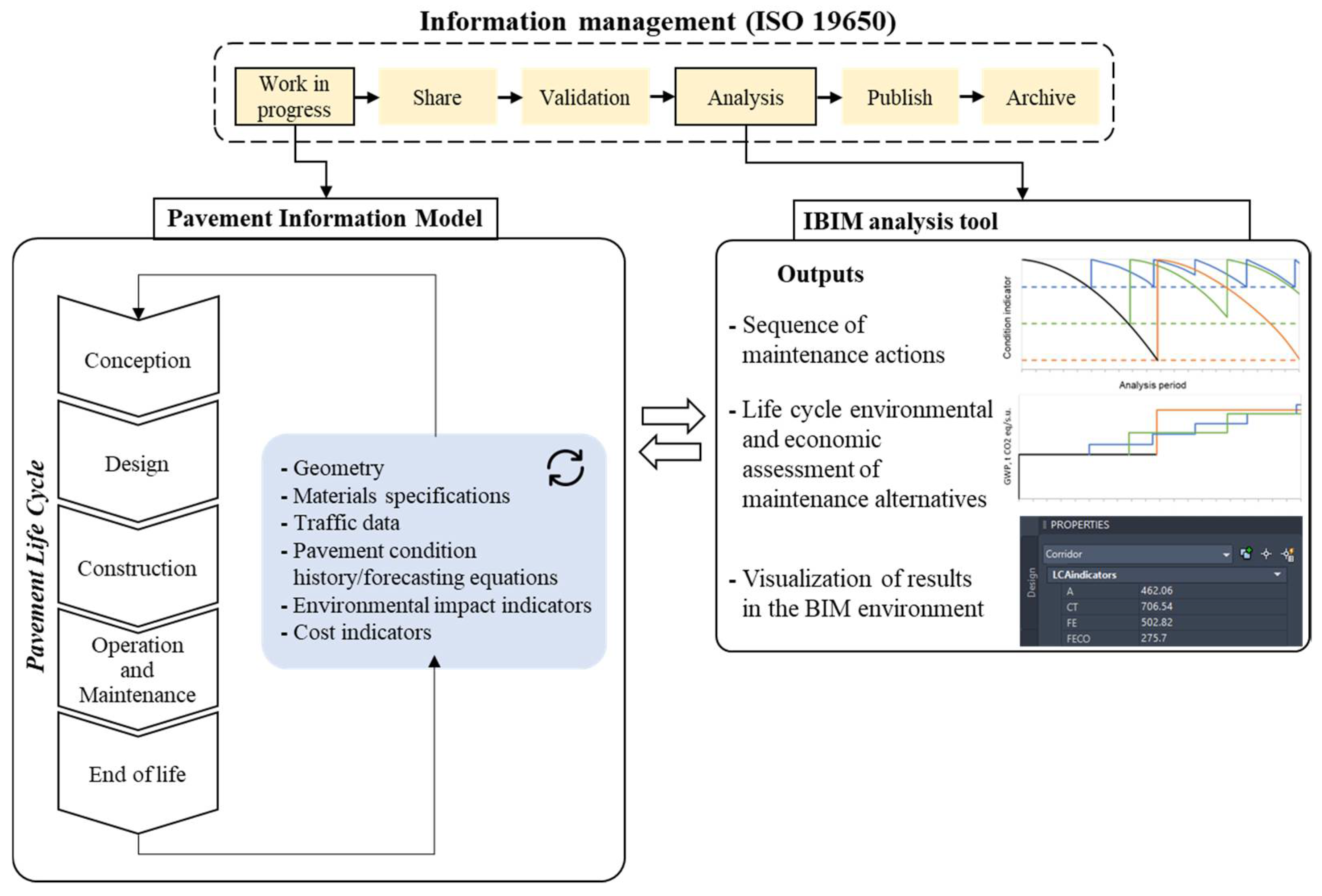
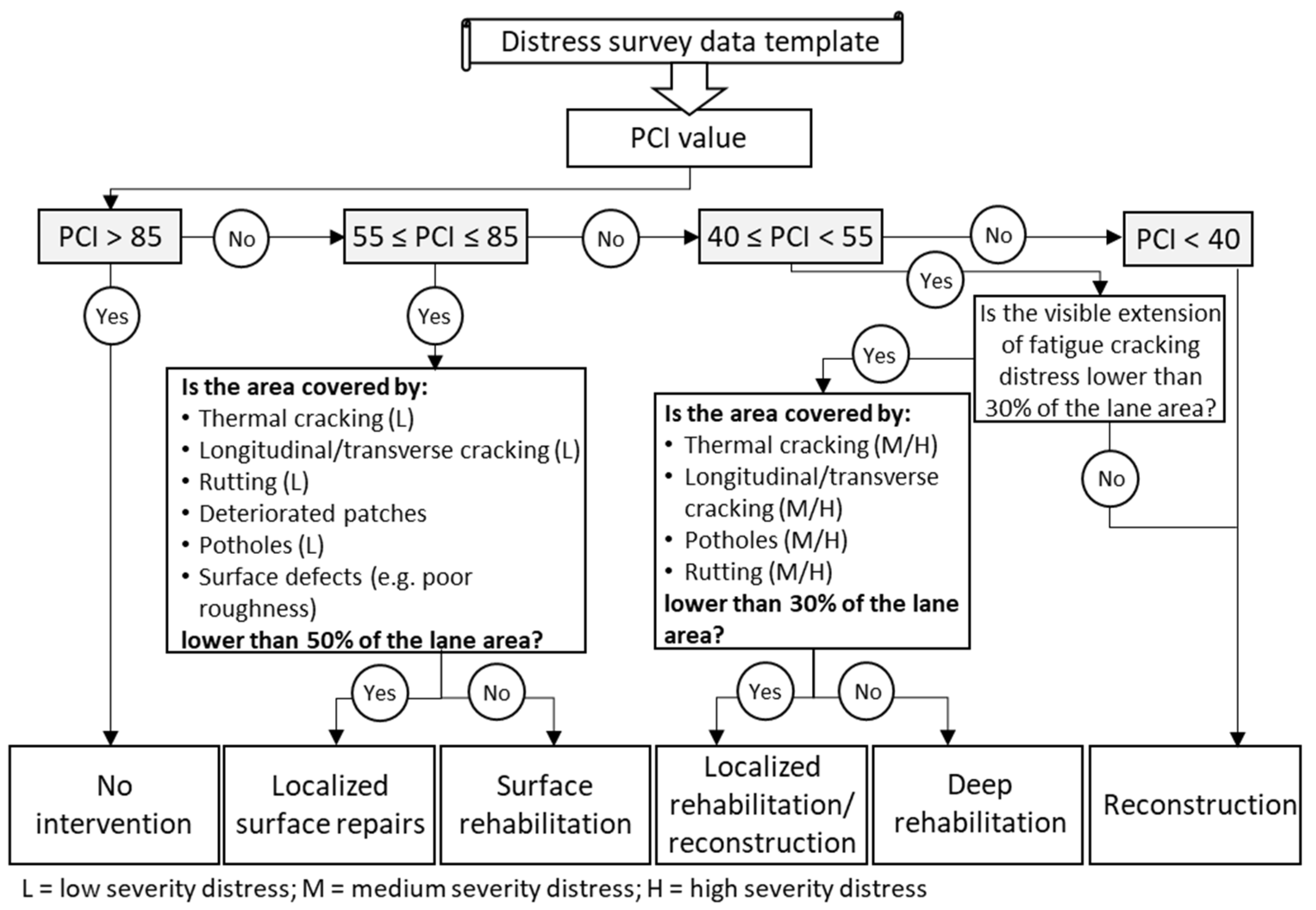
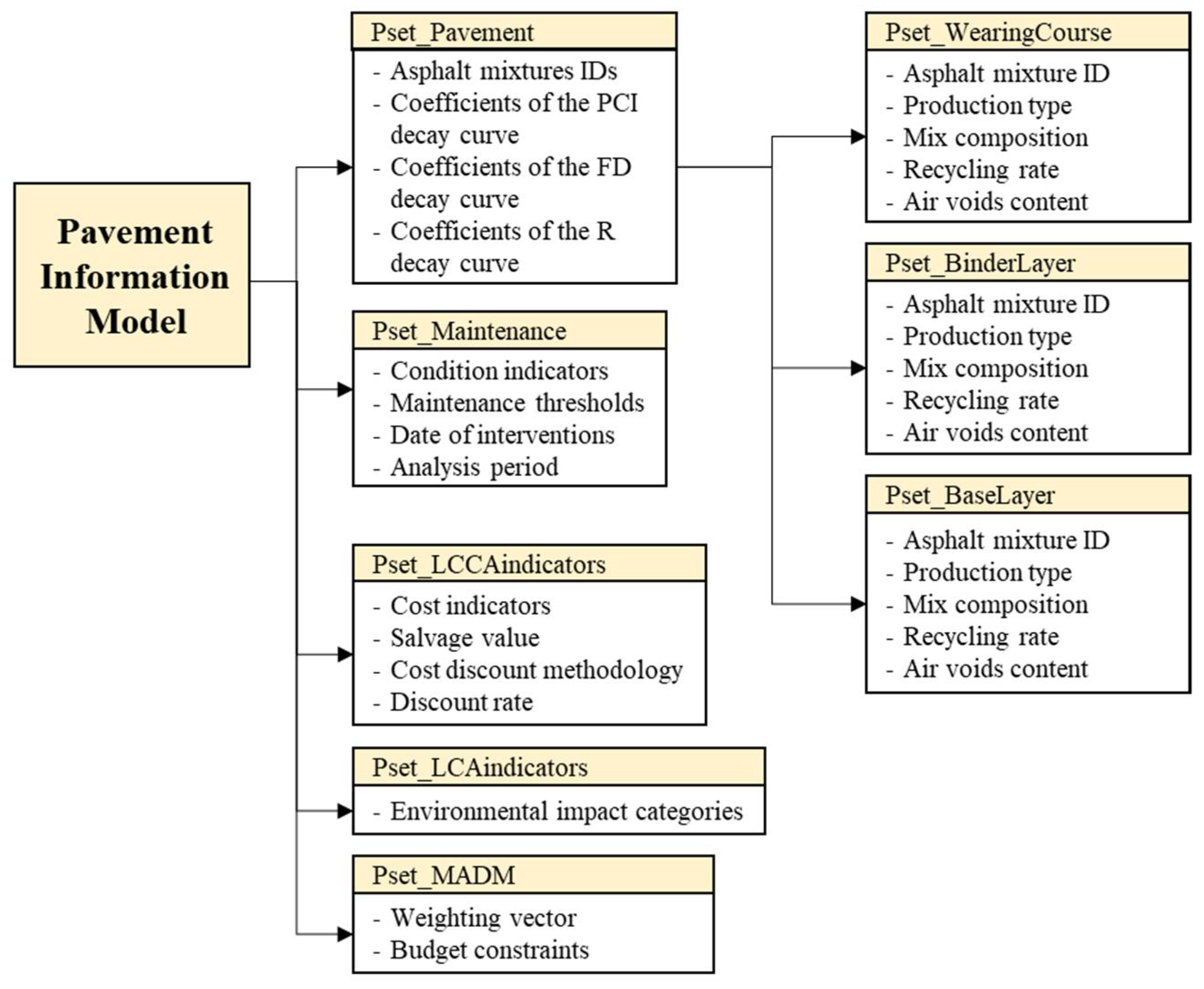
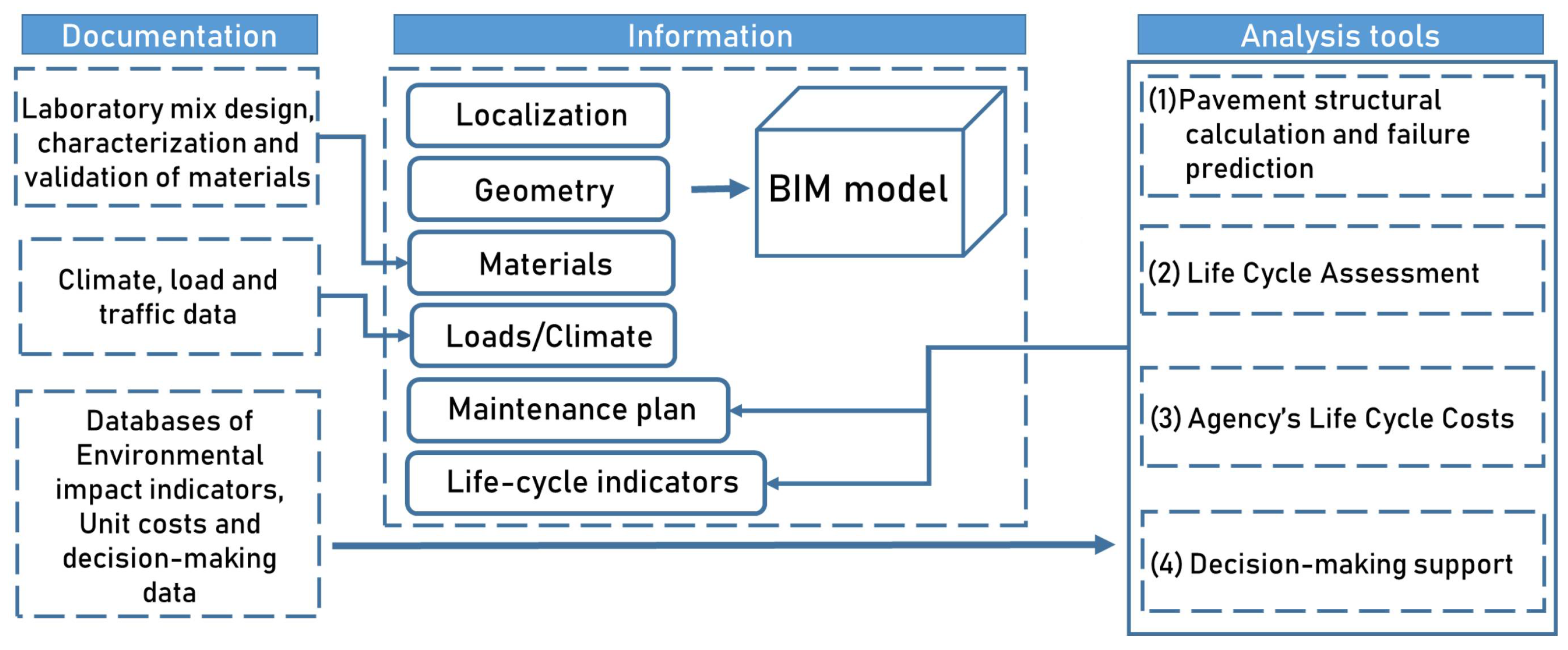
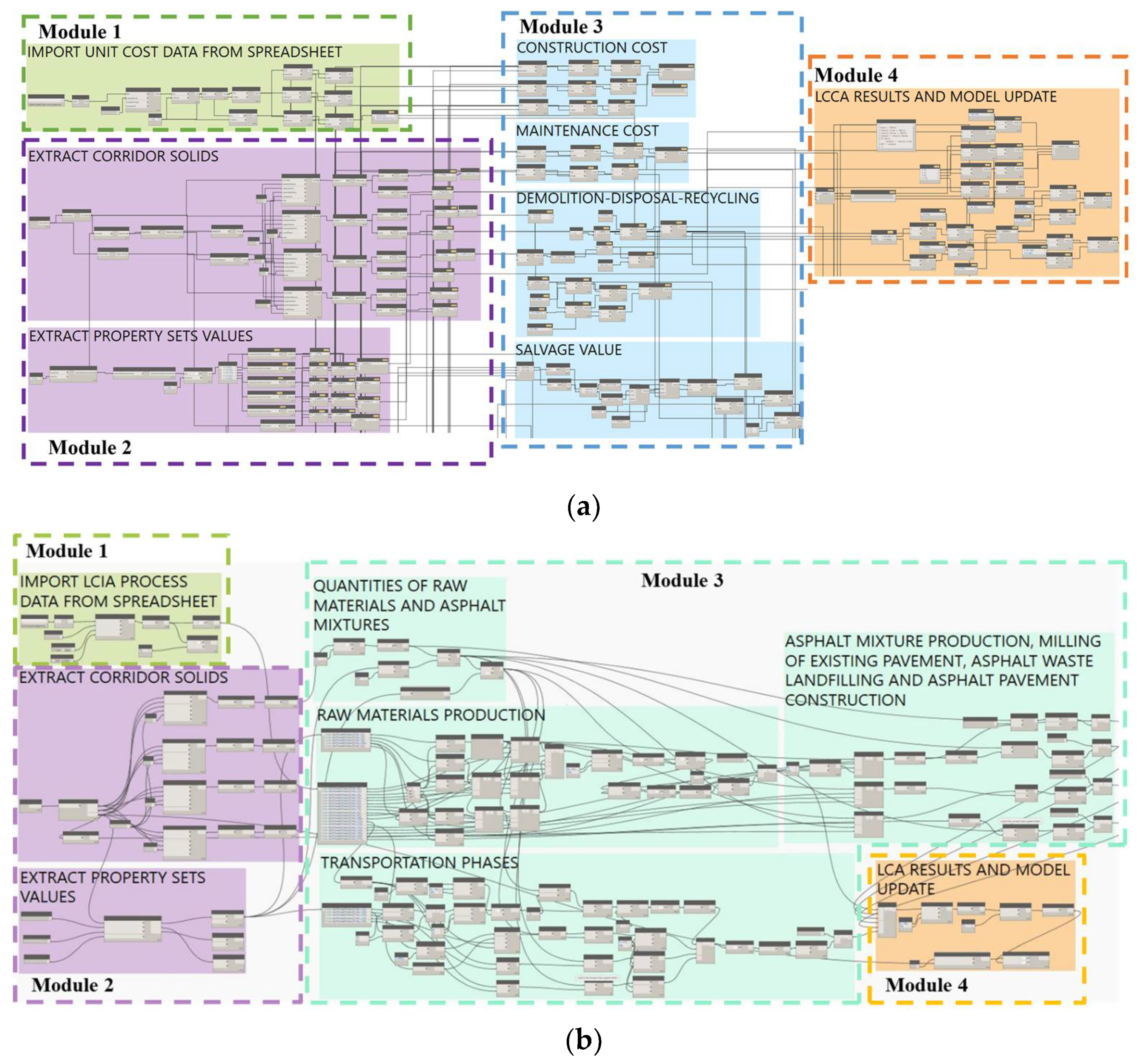
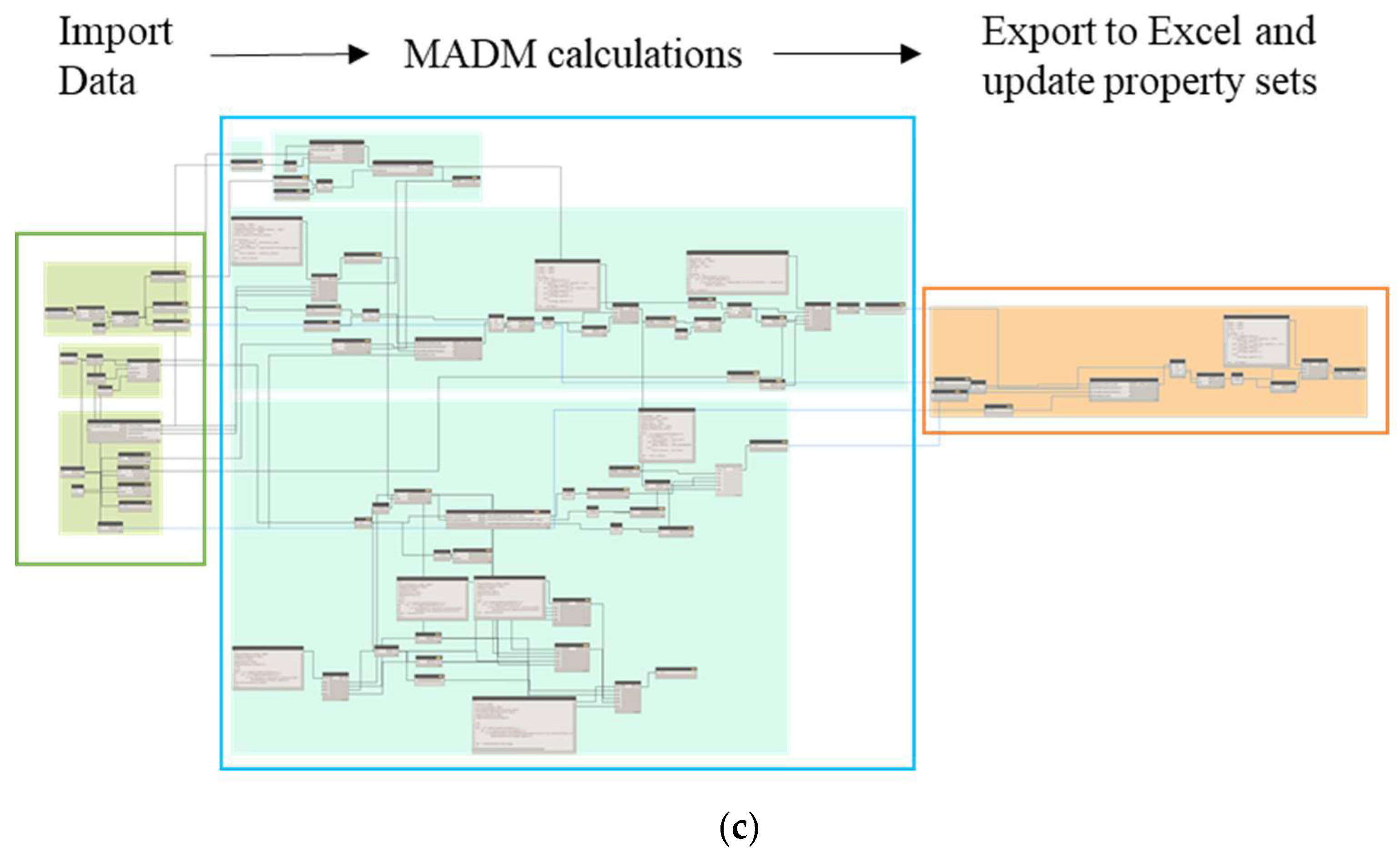
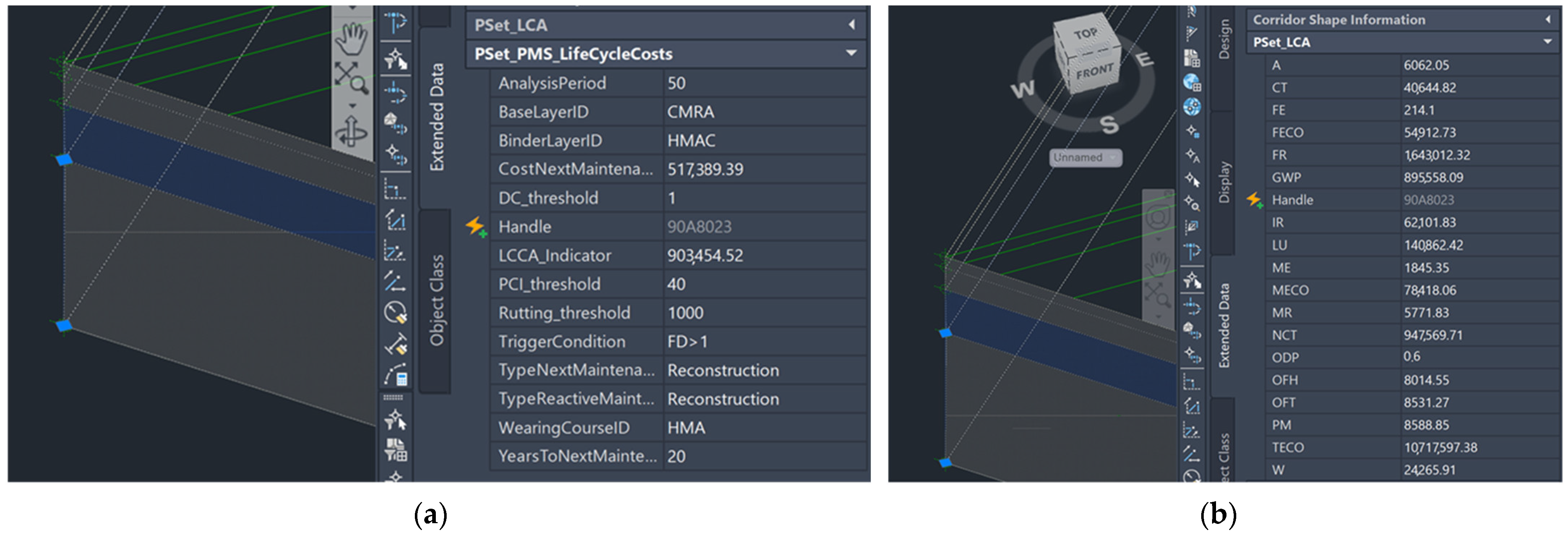
| Life Cycle Phase | Equations |
|---|---|
| General equation of LCA | |
| Raw materials production | |
| Asphalt mixture in-plant production | |
| Road pavement construction | |
| Road pavement maintenance | |
| End-of-life |
| Item | Equations |
|---|---|
| General equation of LCCA | |
| Salvage Value | |
| In-plant asphalt mixture production and supply, road pavement construction | |
| Road pavement maintenance | |
| End-of-life |
Disclaimer/Publisher’s Note: The statements, opinions and data contained in all publications are solely those of the individual author(s) and contributor(s) and not of MDPI and/or the editor(s). MDPI and/or the editor(s) disclaim responsibility for any injury to people or property resulting from any ideas, methods, instructions or products referred to in the content. |
© 2023 by the authors. Licensee MDPI, Basel, Switzerland. This article is an open access article distributed under the terms and conditions of the Creative Commons Attribution (CC BY) license (https://creativecommons.org/licenses/by/4.0/).
Share and Cite
Oreto, C.; Biancardo, S.A.; Abbondati, F.; Veropalumbo, R. Leveraging Infrastructure BIM for Life-Cycle-Based Sustainable Road Pavement Management. Materials 2023, 16, 1047. https://doi.org/10.3390/ma16031047
Oreto C, Biancardo SA, Abbondati F, Veropalumbo R. Leveraging Infrastructure BIM for Life-Cycle-Based Sustainable Road Pavement Management. Materials. 2023; 16(3):1047. https://doi.org/10.3390/ma16031047
Chicago/Turabian StyleOreto, Cristina, Salvatore Antonio Biancardo, Francesco Abbondati, and Rosa Veropalumbo. 2023. "Leveraging Infrastructure BIM for Life-Cycle-Based Sustainable Road Pavement Management" Materials 16, no. 3: 1047. https://doi.org/10.3390/ma16031047
APA StyleOreto, C., Biancardo, S. A., Abbondati, F., & Veropalumbo, R. (2023). Leveraging Infrastructure BIM for Life-Cycle-Based Sustainable Road Pavement Management. Materials, 16(3), 1047. https://doi.org/10.3390/ma16031047









